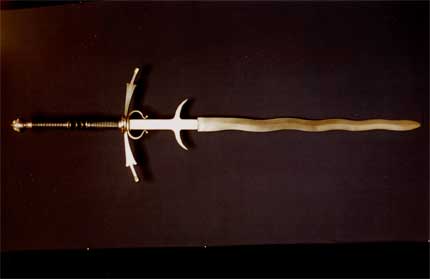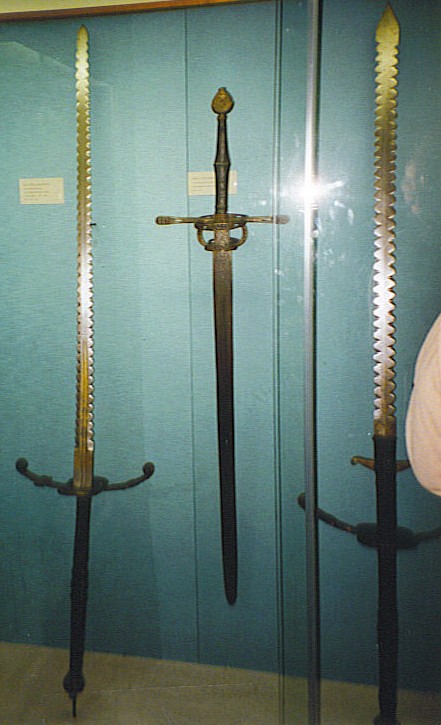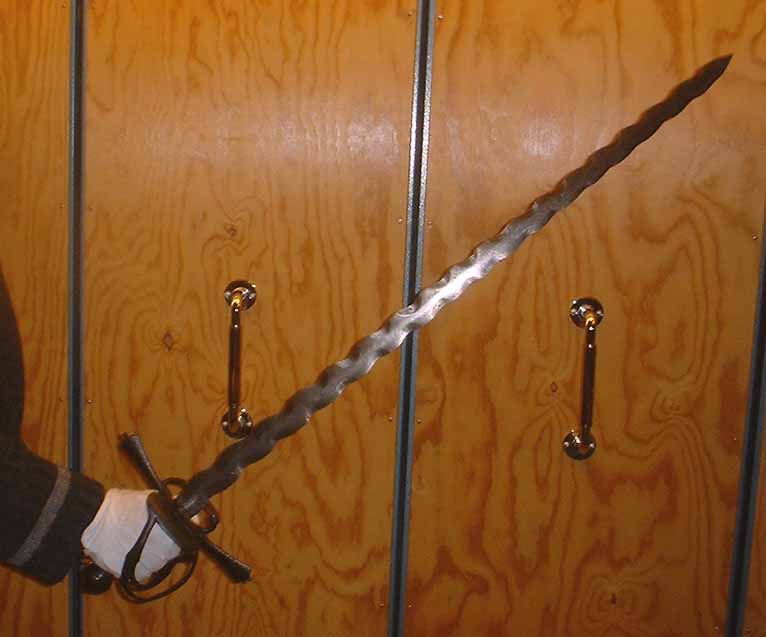| Author |
Message |
|
Kurt Houghton
Location: Kureelpa Joined: 25 May 2009
Posts: 14
|
 Posted: Sun 06 Sep, 2009 5:07 am Post subject: Flamberging a sword Posted: Sun 06 Sep, 2009 5:07 am Post subject: Flamberging a sword |
 |
|
does anyone have any handy help on how to forge out a flamberged sword ???
thanks
Kurtulees 
|
|
   |
 |
|
Anders Backlund
|
 Posted: Sun 06 Sep, 2009 5:35 am Post subject: Posted: Sun 06 Sep, 2009 5:35 am Post subject: |
 |
|
What do you mean by "help"? I'm not sure there's a specific method.
I've never tried making something like that, but if I did I'd probably go by stock removal and grind out the shape of the blade from a straight piece. I'm kinda lazy like that. I assume a more traditional/economy-minded smith would go about it with a lot of bending around the round part of the anvil.
The sword is an ode to the strife of mankind.
"This doesn't look easy... but I bet it is!"
-Homer Simpson.
|
|
  |
 |
|
Kurt Houghton
Location: Kureelpa Joined: 25 May 2009
Posts: 14
|
 Posted: Sun 06 Sep, 2009 5:40 am Post subject: Posted: Sun 06 Sep, 2009 5:40 am Post subject: |
 |
|
well you'd probably start with a very wide peice of metal i could imagine for grinding and i do agree its just to easy to take to stuff with a grinder haha
my thoughts of how you would smith one out would be to twist your blade around..... then to heat it up and belt it flat making sure its white hot and basically weld it back down thus giving you the pattern...... basically, how do you get that pattern forging / blacksmithing.
Kurtulees 
|
|
   |
 |
|
Nicholas A. Gaese
Location: Montreal, Quebec, Canada Joined: 06 Aug 2007
Posts: 100
|
 Posted: Sun 06 Sep, 2009 7:36 am Post subject: Posted: Sun 06 Sep, 2009 7:36 am Post subject: |
 |
|
Hey everyone!
im not a smith or anything so please take my 0.02 cents worth with a grain of salt, but I think your method would depend on which style you mean to make.
As I understand it there are 2 variants of Flambard-style swords: snake or flame bladed, or scalloped edged, the second being my own preference.
With the flame blade I would think that heating and bending the blade around the round part of the anvil would do the trick. The scalloped edge variant is different and I would think much more time consuming to make, as you would essentially be grinding notches into a straight blade stock after you had forged it into its near final shape.
here's some pics for reference on the blade styles and good luck if you decide to make a project out of this, I LOVE big swords 
 Attachment: 5.4 KB Attachment: 5.4 KB

example of flame bladed two hander.
 Attachment: 79.52 KB Attachment: 79.52 KB

Two nice examples of scalloped edged two handers.
 Attachment: 46.24 KB Attachment: 46.24 KB

Here's a cool example of a one handed sword featuring that style of blade.
|
|
  |
 |
|
Kurt Houghton
Location: Kureelpa Joined: 25 May 2009
Posts: 14
|
 Posted: Sun 06 Sep, 2009 3:21 pm Post subject: Posted: Sun 06 Sep, 2009 3:21 pm Post subject: |
 |
|
well im looking more into the landesknechte role of sword, decorative cross very long hande and ofcourse the almost scoloped shape.
This sword here pretty much sums up what my next project will be within a week or two
http://www.realmcollections.com/images/pl/Swo...30_125.jpg
only possibly with more of a flamberge like the photo shown with the 3 swords against a wall.
thanks for your .02 cents worth  [/img] [/img]
Kurtulees 
|
|
   |
 |
|
Allen Jones
Location: NC, USA Joined: 10 Apr 2008
Posts: 18
|
 Posted: Sun 06 Sep, 2009 4:28 pm Post subject: Posted: Sun 06 Sep, 2009 4:28 pm Post subject: |
 |
|
I think the sword you posted had its famberge ground in, instead of forged. I think even the 3 swords on the wall that Nicholas posted had their famberge ground in. They most likely were forged like a normal broadsword and then the edge ground in making that "saw tooth" look.
I would guess that the first sword Nicholas posted was forged like a normal broadsword but before the edge was fully forged the spine of the blade was bent using the horn of the anvil.
The last sword look more like the edge was forged with a large ball pein hammer to create the famberge.
I have never tried to forge a flamberge before, but that is what I think they look like.
|
|
  |
 |
|
Nicholas A. Gaese
Location: Montreal, Quebec, Canada Joined: 06 Aug 2007
Posts: 100
|
 Posted: Sun 06 Sep, 2009 4:37 pm Post subject: Posted: Sun 06 Sep, 2009 4:37 pm Post subject: |
 |
|
Hey Kurt, your very welcome!
The example you posted is a reproduction from Ritter Steel if im not mistaken. It's a rather heavy sword because it is made with no taper at all except at around the center of the blade and if I remember right it weighed around 13 lbs.
If you need any ideas for styles for blade and hilt were more than happy to help. The Landsknecht are my personal favorite figures in history and as such Ive become quite fond of the two-handers that they are often shown weilding, whether its the classic Flambard style or the less decorative straight bladed versions resembling the sword from the movie "Brave Heart".
Also If you haven't already check out the photo Album feature on this website and look at Antique arms and armor. There's a whole section filled with photos of Bidenhandschwerts, which the photo above was actually taken from.
looking forward to another two hander project being done and please post your progress as you go along, many of us love watching these things come to life  and again good luck! and again good luck!
|
|
  |
 |
|
Nicholas A. Gaese
Location: Montreal, Quebec, Canada Joined: 06 Aug 2007
Posts: 100
|
 Posted: Sun 06 Sep, 2009 5:01 pm Post subject: Posted: Sun 06 Sep, 2009 5:01 pm Post subject: |
 |
|
Hey Allen! I think you hit the nail on the head about the edges. as I said before the scalloped edges are usually ground after the blade had been forged to its near final shape. I would think your right about the other swords as well, just looking at them can give an idea as to how they are made.
In the case of the sword that kurt posted the blade stock is about 3/16 inch thick by 2 inches wide and the edges look ground on. With this sword they wanted it to look like the flambard blades that widen out towards the tip. Whether because of cost or other variables they seem to stay with the 2 inch wide stock and narrow the base of the scalloped section to make the tip look wider than it actually is. The one problem with this is that it becomes harder to ground the proper edges in because you begin to run out of material so it doesn't have the proper shape it should, that is why it looks less distinct.
|
|
  |
 |
|
Kurt Houghton
Location: Kureelpa Joined: 25 May 2009
Posts: 14
|
 Posted: Sun 06 Sep, 2009 11:51 pm Post subject: Posted: Sun 06 Sep, 2009 11:51 pm Post subject: |
 |
|
Well thankyou all for your help, i think that the most efficient way would be to grind it back very carefully then take it in closer with a file....
That project will come closer more so towards next wednesday  I am quite fond of the 2 handers and what not, especially due to german long sword training. I am quite fond of the 2 handers and what not, especially due to german long sword training.
Can you also help with a Lucerne hammer, just some background as i've never seen one re-created.
Does it have 2 prong hammer or a 4 prong hammer??
Were they spikes or blades?? as i could imagine both would have there advantages and dis-advantages....
thanks again
Kurtulees 
|
|
   |
 |
Chad Arnow
myArmoury Team


|
 Posted: Mon 07 Sep, 2009 6:55 am Post subject: Posted: Mon 07 Sep, 2009 6:55 am Post subject: |
 |
|
| Kurt Houghton wrote: | Can you also help with a Lucerne hammer, just some background as i've never seen one re-created.
Does it have 2 prong hammer or a 4 prong hammer??
Were they spikes or blades?? as i could imagine both would have there advantages and dis-advantages....
thanks again |
Why not start a new topic, since this one is about flamberge blades? As you think about your new thread, consider reading our feature article on the Medieval Poleaxe.

ChadA
http://chadarnow.com/
|
|
    |
 |
|
|

